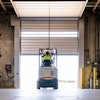
 Joseph Bove
Joseph BoveWhether you’re designing a new food and beverage facility or renovating an existing one, it’s important to consider the materials you choose for to surround your processing — literally.
When it comes to food safety, these features sometimes get less attention than other factors — such as equipment, ingredient storage/segregation and product handling — but they can be a plant’s Achilles heel if ignored. We’re going to look at the best practices when selecting materials for your facility’s flooring, walls, ceilings and doors.
Flooring
When it comes to selecting a flooring system for your facility, I recommend a fluid-applied flooring — either epoxy or polyurethane. Of course, the exact type of flooring that is best for your facility ultimately depends on the type of product you’re manufacturing and what chemicals and temperatures will be hitting the floor during cleaning.
Many would argue that the best flooring option is dairy brick with epoxy grout, which is extremely durable. This is a great flooring option for food manufacturers, but the downside is that it’s very expensive.
Another big consideration for your flooring is drain location: You want to have enough properly placed drains so that you don’t have to push water very far before getting rid of it. Plus, floors that don’t drain properly can create standing water and excess moisture which can lead to mold growth.
We don’t usually recommend trench drains or slot drains because they can increase the risk of bacterial harborage. Instead, I typically opt for stainless steel drains because they’re non-corrosive (compared to regular steel) and can withstand high-temperature water used in sanitation.
Walls And Ceilings
At Stellar, we utilize some type of metal panel system for all of the walls and ceilings we design and construct for clients. Typically, we use insulated metal panels (IMP), because they are quick to install, cost-efficient and cleanup-friendly.
IMPs are a great choice for ensuring food safety and they last a long time. IMPs are made for durability, so they can withstand getting hit by high-pressure hose reels, hot water and chemical cleaners. For plants that have a nightly sanitation cycle, these panels can last for 15 years with minimal maintenance (i.e., only re-caulking the panel joints every seven years).
You typically want to avoid any porous materials in a food and beverage plant. For example, concrete is porous, which means bacteria can grow in those hard-to-clean pockets. If your plant has an existing concrete wall, you could paint it with epoxy or urethane, but it’s not ideal. Bottom line: If you’re building new, IMP is the way to go.
Doors
Your facility’s doors are critical to food safety because they can present a major, ongoing risk for contamination. Interior facility doors should be in proper operating condition and have proper air seals on all four sides. With exterior doors, it’s important to continually maintain the rubber sweeps at the bottom.
A good way to test the seal at the bottom of your doors is to try to fit a piece of paper under the door or shine a flashlight at it. If you can slip a sheet of paper through or if you can see the light from the other side, that’s a red flag. Exterior doors may need attention every year, and that rubber sweep may need to be replaced or adjusted multiple times per year.
About Stellar
Stellar is a fully integrated firm focused on planning, design, pre-construction, construction, refrigeration, mechanical & utility, building envelope, and total operations & maintenance services worldwide. Visit the company's blog at www.stellarfoodforthought.net or learn about its projects at stellar.net.






















